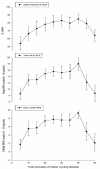Exercise Intensity and Validity of the Ratings of Perceived Exertion (Borg and OMNI Scales) in an Indoor Cycling Session
- PMID: 24511345
- PMCID: PMC3916918
- DOI: 10.2478/hukin-2013-0072
Exercise Intensity and Validity of the Ratings of Perceived Exertion (Borg and OMNI Scales) in an Indoor Cycling Session
Abstract
1) to determine the intensity of an indoor cycling session; 2) to know the correlation between the rating of perceived exertion (RPE) scales (Borg and OMNI) and % heart rate reserve (%HRR) with categories; and 3) to evaluate the validity of RPE scales (Borg and OMNI) with respect to the heart rate (HR) and %HRR. A total of fifty-three subjects, 25 males and 28 females (ages: 28.79 ± 6.04 years; body height: 1.71 ± 0.09 m; body mass: 69.59 ± 13.69 kg) were recruited from a private fitness club. All subjects performed the same predesigned indoor cycling session with a total duration of 50 minutes. During the experimental trial, the HR was recorded every 5 s. The Borg 6-20 RPE and OMNI 0-10 scales were used to assess perceived exertion in each phase. The average HR in the cardiovascular phase was 152.24 ± 14.11 b•min-1, the %HRR was 80.62 ± 7.10; and the overall RPE (Borg and OMNI scales) was 14.94 ± 1.11 and 7.18 ± 0.79 points, respectively. The correlation between an average HR and %HRR with Borg and OMNI scales was lower than r = 0.4 (p < 0.05). The correlation value between the Borg and the OMNI RPE scales was r = 0.82 (p < 0.001). It can be concluded that indoor cycling elicits effort of high intensity which could be inappropriate for some participants. The Borg and OMNI scales showed a low validity to quantify the intensity performed in indoor cycling sessions. It indicates the necessity to control the intensity of effort with other instruments to improve efficacy and decrease the risk of overload in this activity.
Keywords: Spinning®; aerobic; cardiovascular; effort; fitness; wellness.
Figures
Similar articles
-
Reliability and validity of the Borg and OMNI rating of perceived exertion scales in adolescent girls.Med Sci Sports Exerc. 2002 Dec;34(12):2057-61. doi: 10.1097/00005768-200212000-00029. Med Sci Sports Exerc. 2002. PMID: 12471316 Clinical Trial.
-
Comparison of Borg- and OMNI-RPE as markers of the blood lactate response to exercise.Med Sci Sports Exerc. 2006 Jul;38(7):1348-52. doi: 10.1249/01.mss.0000227322.61964.d2. Med Sci Sports Exerc. 2006. PMID: 16826034
-
Construct validity of the OMNI resistance exercise scale.J Strength Cond Res. 2006 May;20(2):252-6. doi: 10.1519/R-17224.1. J Strength Cond Res. 2006. PMID: 16686549
-
Rating of perceived exertion on resistance training in elderly subjects.Expert Rev Cardiovasc Ther. 2019 Feb;17(2):135-142. doi: 10.1080/14779072.2019.1561278. Epub 2019 Jan 7. Expert Rev Cardiovasc Ther. 2019. PMID: 30569775 Review.
-
Rating of perceived exertion (RPE) in studies of fatigue-induced postural control alterations in healthy adults: Scoping review of quantitative evidence.Gait Posture. 2021 Oct;90:167-178. doi: 10.1016/j.gaitpost.2021.08.015. Epub 2021 Aug 25. Gait Posture. 2021. PMID: 34492503
Cited by
-
An allied health rehabilitation program for patients following surgery for abdomino-pelvic cancer: a feasibility and pilot clinical study.Support Care Cancer. 2020 Mar;28(3):1335-1350. doi: 10.1007/s00520-019-04931-w. Epub 2019 Jun 27. Support Care Cancer. 2020. PMID: 31250182 Clinical Trial.
-
Breathing Pattern Disorders Distinguished from Healthy Breathing Patterns Using Optoelectronic Plethysmography.Transl Sports Med. 2022 Dec 3;2022:2816781. doi: 10.1155/2022/2816781. eCollection 2022. Transl Sports Med. 2022. PMID: 38655165 Free PMC article.
-
Influence of Ambient Temperature on Autonomic Nerve Function and Peripheral Sensation from Moderate-Intensity Treadmill Exercise.Int J Exerc Sci. 2024 Apr 1;17(2):491-503. doi: 10.70252/EFCE3145. eCollection 2024. Int J Exerc Sci. 2024. PMID: 38665327 Free PMC article.
-
High intensity interval training protects the heart during increased metabolic demand in patients with type 2 diabetes: a randomised controlled trial.Acta Diabetol. 2019 Mar;56(3):321-329. doi: 10.1007/s00592-018-1245-5. Epub 2018 Nov 1. Acta Diabetol. 2019. PMID: 30387015 Free PMC article. Clinical Trial.
-
Brazilian Guideline for Exercise Testing in Children and Adolescents - 2024.Arq Bras Cardiol. 2024 Sep 16;121(8):e20240525. doi: 10.36660/abc.20240525. Arq Bras Cardiol. 2024. PMID: 39292116 Free PMC article. English, Portuguese.
References
-
- Battista RA, Foster C, Andrew J, Wright G, Lucia A, Porcari JP. Physiologic responses during indoor cycling. J Strength Cond Res. 2008;22:1236–1241. - PubMed
-
- Bianco A, Bellafiore M, Battaglia G, Paoli A, Caramazza G, Farina F, Palma A. The effects of indoor cycling training in sedentary overweight women. J Sports Med Phys Fitness. 2010;50:159–165. - PubMed
-
- Caria MA, Tangianu F, Concu A, Crisafulli A, Mameli O. Quantification of Spinning bike performance during a standard 50-minute class. J Sports Sci. 2007;25:421–429. - PubMed
-
- Coquart JB, Garcin M. Validity and reliability of perceptually-based scales during exhausting runs in trained male runners. Percept Mot Skills. 2007;104:254–266. - PubMed
-
- Crumpton S, Scharff-Olson M, Williford HN, Bradford A, Walker S. The effects of a comercially-produced “Spinning” video: Aerobic responses and caloric expenditure. Med Sci Sports Exerc. 1999;31:S112.
LinkOut - more resources
Full Text Sources
Other Literature Sources
Medical

